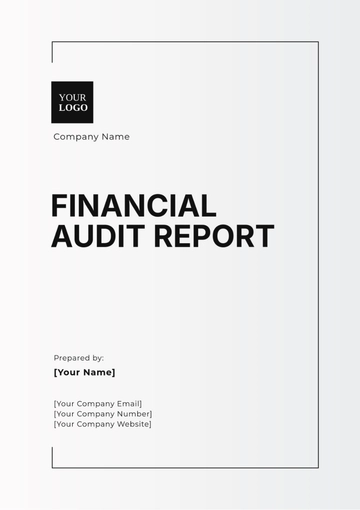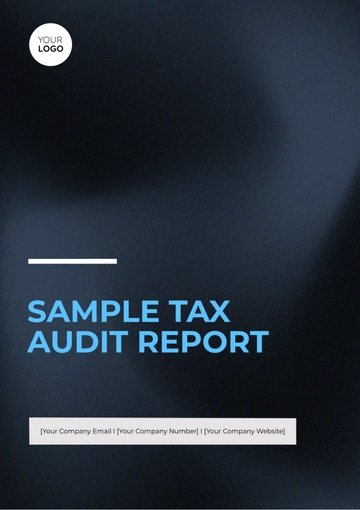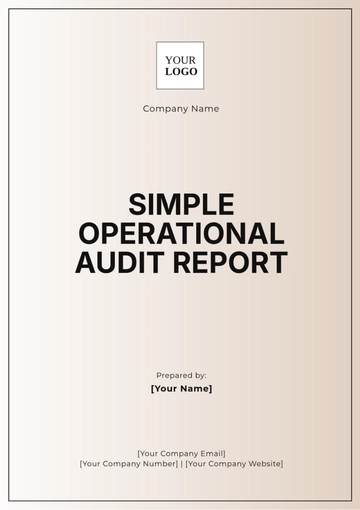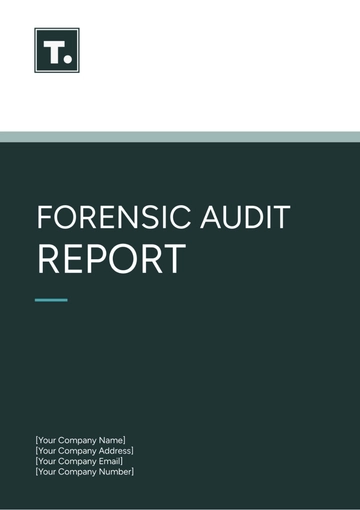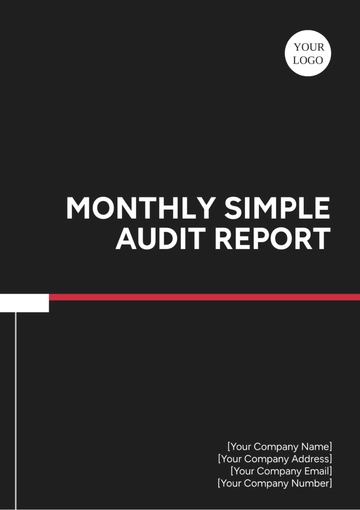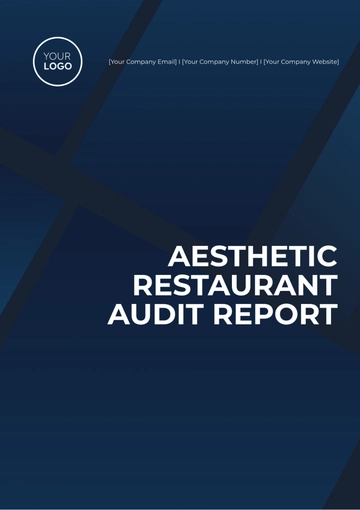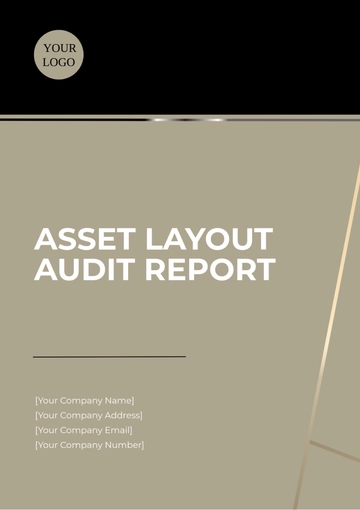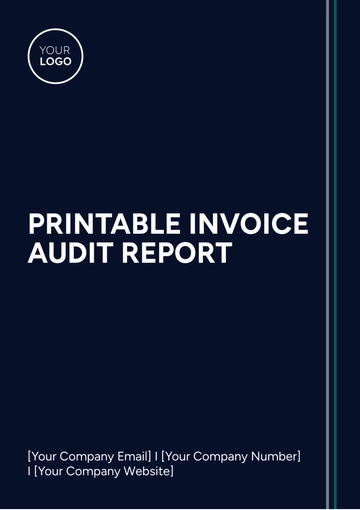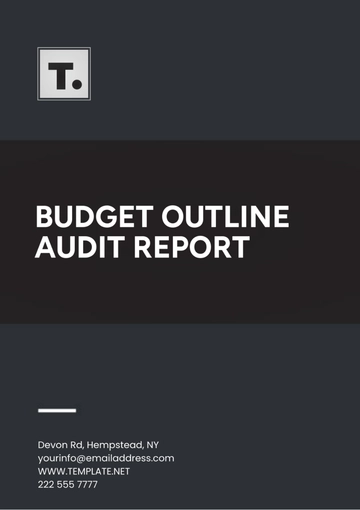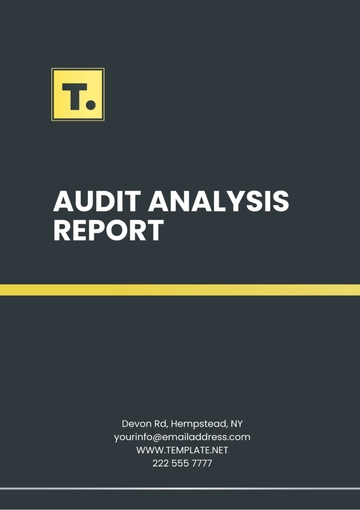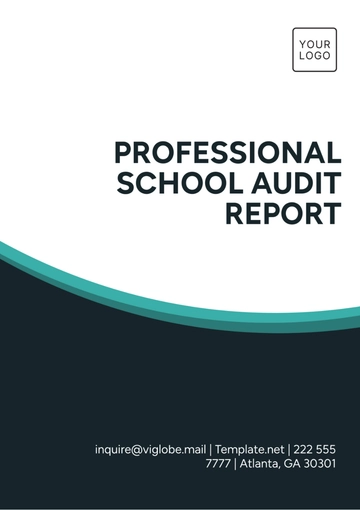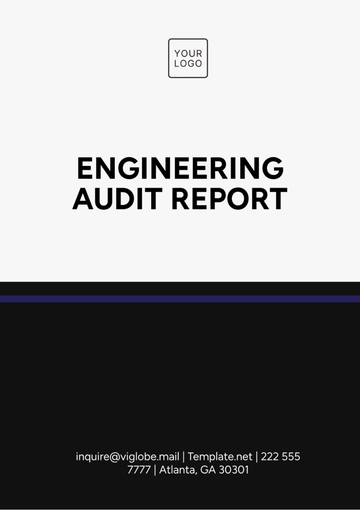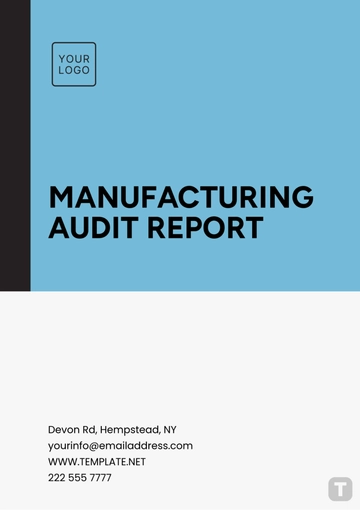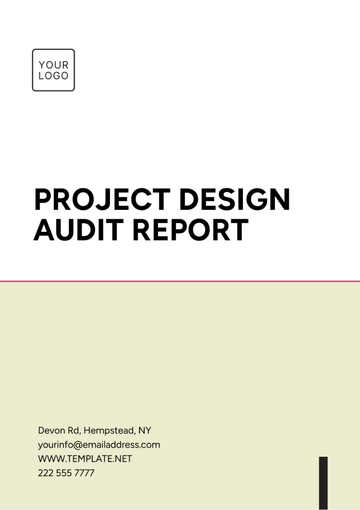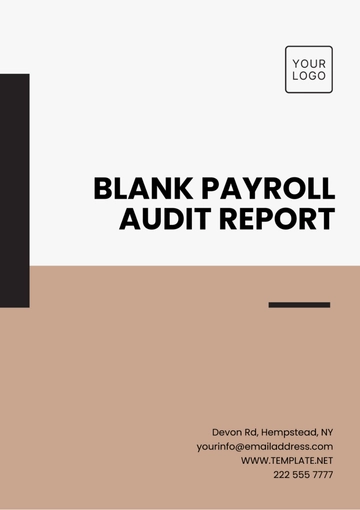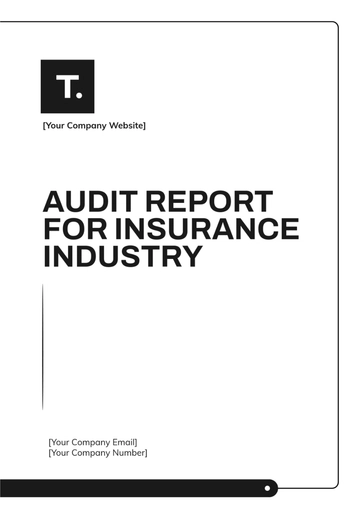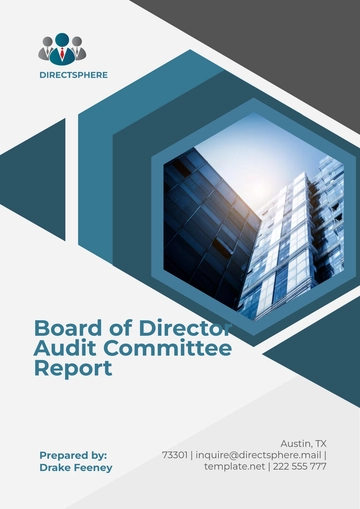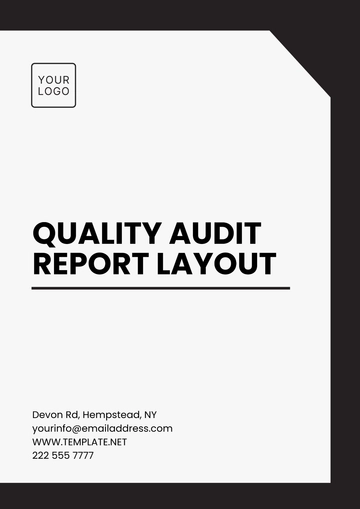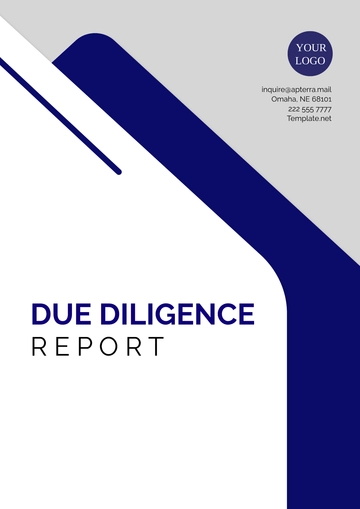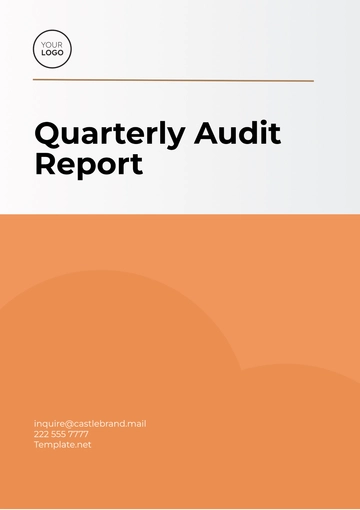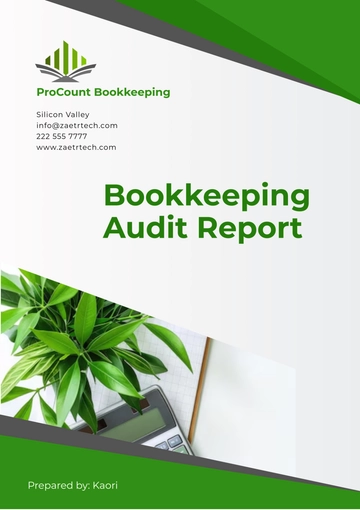Free Nursing Home Compliance Audit Report
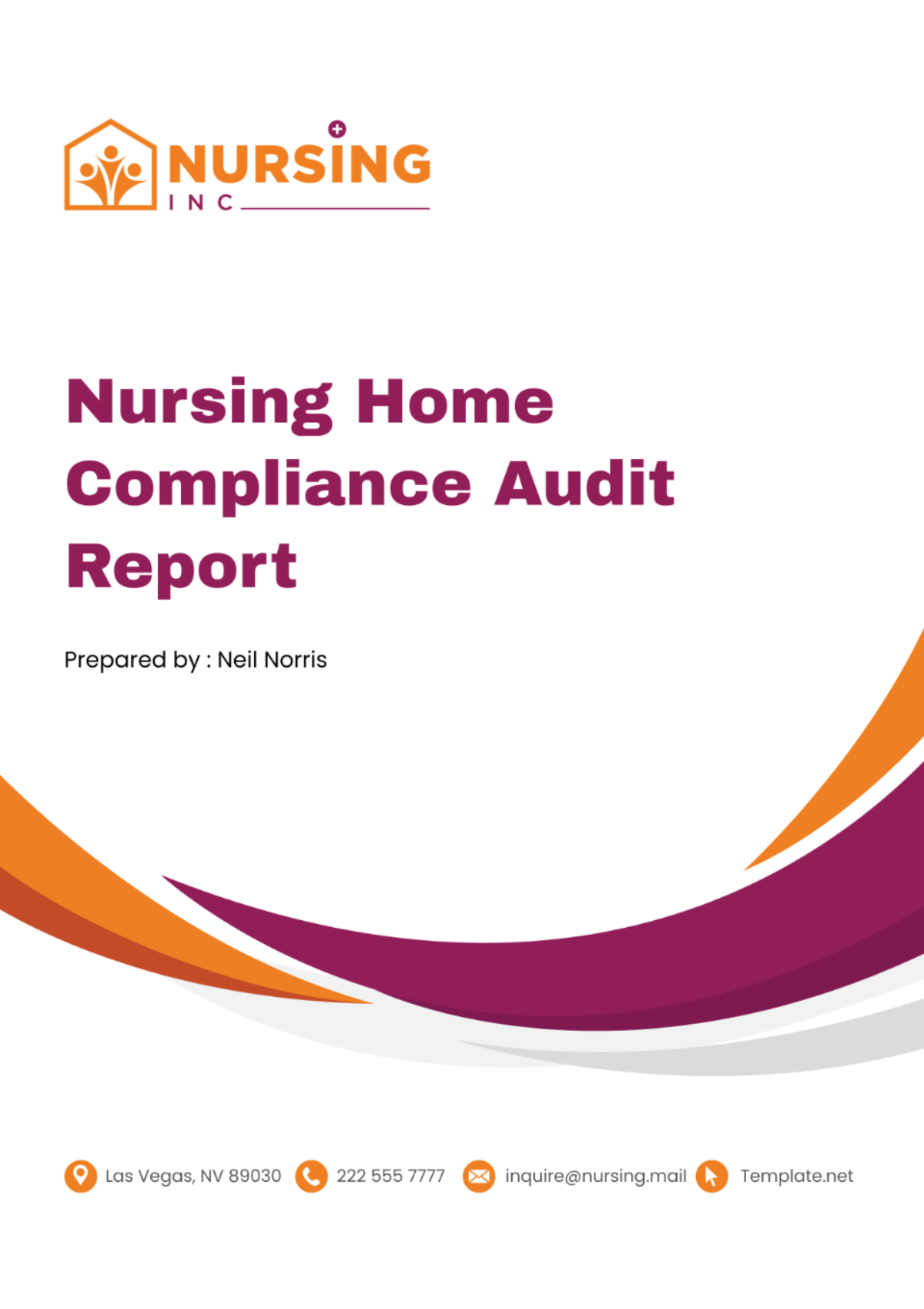
I. Executive Summary
A. Introduction
The audit conducted by [Your Company Name], named the "QualityCare Audit," aimed to comprehensively evaluate the compliance status of [Nursing Home Name] with regulatory standards and guidelines established by the Centers for Medicare & Medicaid Services (CMS) and state health departments. The objective was to ensure the provision of high-quality care and safety for the residents.
B. Key Findings
Aspect | Compliance Rating |
|---|---|
Governance and Administration | 4 out of 5 |
Clinical Care and Services | 3.5 out of 5 |
Staffing and Training | 4.5 out of 5 |
Quality Assurance | 3.8 out of 5 |
Environmental Safety | 4.2 out of 5 |
Infection Control | 3.9 out of 5 |
Areas of Non-Compliance: Despite an overall satisfactory compliance rating, the audit identified specific areas of non-compliance, notably in infection control protocols and documentation of quality assurance activities. These areas require immediate attention to mitigate risks and enhance resident safety.
Notable Observations: Notable observations during the audit included inconsistencies in staff training records and lapses in infection control practices during direct observations. These observations highlight areas for improvement to ensure consistent adherence to regulatory standards.
C. Recommendations
Corrective Actions
Immediate Actions: Immediate corrective actions should prioritize retraining staff on infection control protocols, updating documentation procedures to ensure accuracy and completeness, and implementing stricter monitoring protocols to prevent recurrence of non-compliance.
Long-term Strategies: Long-term strategies should focus on establishing a robust continuous quality improvement program, enhancing infection control training for all staff members, and implementing regular audits to monitor compliance and identify areas for improvement proactively.
II. Introduction
A. Background
Regulatory Framework
Overview of Applicable Regulations: The audit was conducted in accordance with regulations set forth by CMS and state health departments, including but not limited to the Nursing Home Reform Act, Conditions of Participation, and state-specific licensing requirements. These regulations establish standards for resident care, staffing, facility management, and quality assurance, among others.
Importance of Compliance: Compliance with regulatory standards is paramount to ensuring the safety, well-being, and rights of nursing home residents. Non-compliance can lead to regulatory sanctions, fines, reputational damage, and, most importantly, jeopardize the health and safety of vulnerable residents. Maintaining compliance also ensures the facility's eligibility for Medicare and Medicaid funding, which is essential for financial sustainability.
B. Scope of the Audit
Audit Objectives
Compliance Assessment: The primary objective of the audit was to comprehensively assess [Nursing Home Name]'s compliance with regulatory standards across key areas, including governance, clinical care, staffing, quality assurance, environmental safety, and infection control. The audit aimed to identify areas of non-compliance and opportunities for improvement to enhance the quality of care provided to residents.
Risk Identification: In addition to assessing compliance, the audit sought to identify potential risks and vulnerabilities within the facility's operations that could impact resident safety and quality of care. By identifying and addressing these risks proactively, the facility can mitigate potential harm to residents and improve overall outcomes.
C. Methodology
Audit Process
Pre-Audit Preparation: Before commencing the audit, [Your Company Name] conducted a thorough review of relevant regulations, including federal and state statutes, regulations, and guidelines applicable to nursing home operations. An audit team was assembled, comprising experienced auditors with expertise in nursing home compliance and clinical care. The team developed an audit plan tailored to the specific regulatory requirements and operational characteristics of [Nursing Home Name].
On-site Inspection: The on-site inspection phase involved a comprehensive review of facility operations, including but not limited to facility infrastructure, resident care practices, staff training, documentation practices, quality assurance processes, environmental safety measures, and infection control protocols. The audit team conducted interviews with key stakeholders, including facility administrators, nursing staff, direct care providers, and residents (where appropriate), to gather insights into day-to-day operations and compliance practices.
Data Collection: Data collection methods included document review, direct observation of care practices, interviews, and analysis of resident records, incident reports, and quality assurance documentation. The audit team meticulously documented findings, including instances of compliance and non-compliance, observations, and areas for improvement. Data collected during the audit were systematically analyzed to identify trends, patterns, and areas of concern, forming the basis for audit findings and recommendations.
III. Compliance Assessment
A. Governance and Administration
Leadership Structure
Organizational Chart: The organizational chart of [Nursing Home Name] illustrates a hierarchical structure with clear delineation of roles and responsibilities. The chart encompasses key personnel such as the administrator, director of nursing, department heads, and unit managers, providing a transparent view of the facility's leadership framework.
Governance Policies: A comprehensive review of governance policies and procedures reveals [Nursing Home Name]'s commitment to effective governance and administration. Policies related to decision-making processes, risk management, and compliance oversight are documented and regularly updated to reflect current regulatory requirements and best practices.
B. Clinical Care and Services
Resident Care Plans
Review of Care Plans: An in-depth examination of resident care plans demonstrates [Nursing Home Name]'s dedication to personalized care. Each resident's care plan is meticulously crafted based on a comprehensive assessment of their medical history, physical and cognitive abilities, preferences, and goals. The care plans are updated regularly to reflect changes in the resident's condition or preferences, ensuring continuity and responsiveness in care delivery.
Implementation of Care Plans: Direct observations and staff interviews confirm the effective implementation of care plans at [Nursing Home Name]. Caregivers and nursing staff are diligent in following the prescribed care interventions outlined in the plans, ensuring that residents receive the appropriate level of support and assistance tailored to their individual needs.
C. Staffing and Training
Staffing Levels
Staffing Ratios: Analysis of staffing ratios at [Nursing Home Name] indicates compliance with regulatory standards and industry benchmarks. Adequate staffing levels are maintained across all shifts and departments, ensuring that residents receive timely and quality care.
Training Programs: [Nursing Home Name] prioritizes staff training and development to ensure competence and proficiency among its workforce. Comprehensive training programs cover a wide range of topics, including resident care techniques, infection control protocols, dementia care, communication skills, and resident rights. Training sessions are conducted regularly, and staff members are encouraged to participate in continuing education opportunities to enhance their knowledge and skills.
D. Quality Assurance and Performance Improvement
QA/QI Processes
QA/QI Initiatives: [Nursing Home Name] demonstrates a strong commitment to quality assurance and performance improvement through the implementation of proactive initiatives. Regular quality audits are conducted to assess compliance with regulatory standards and identify areas for improvement. Additionally, resident satisfaction surveys are administered periodically to gather feedback and insights into the resident experience. Interdisciplinary team meetings provide a forum for staff collaboration and problem-solving, facilitating continuous quality improvement efforts.
Performance Metrics: [Nursing Home Name] tracks and monitors key performance metrics to measure the effectiveness of its quality assurance efforts. Metrics such as medication error rates, incidence of pressure ulcers, falls, and resident satisfaction scores are analyzed regularly to identify trends, patterns, and areas for targeted intervention. Data-driven decision-making ensures that resources are allocated effectively to address areas of concern and enhance overall resident outcomes.
IV. Risk Identification
A. Environmental Safety
Facility Safety Measures
Emergency Preparedness: [Nursing Home Name] has established robust emergency preparedness protocols to safeguard residents and staff in the event of emergencies. The facility conducts regular emergency drills and simulations to ensure staff readiness and familiarity with evacuation procedures, emergency communication protocols, and response strategies. Emergency supply kits are stocked and maintained to meet regulatory requirements and facilitate a swift and coordinated response in crisis situations.
Environmental Hazards: [Nursing Home Name] conducts comprehensive environmental safety assessments to identify and mitigate potential hazards within the facility. Routine inspections of the physical environment are conducted to address issues such as slip and trip hazards, faulty equipment, environmental contaminants, and infection control risks. Prompt corrective action is taken to address identified hazards and maintain a safe and secure environment for residents, staff, and visitors.
B. Infection Control
Infection Prevention Protocols
Hand Hygiene Compliance: Observations of staff adherence to hand hygiene protocols consistently demonstrate high compliance rates at [Nursing Home Name]. Hand hygiene stations are strategically located throughout the facility, equipped with alcohol-based hand sanitizers and handwashing facilities to promote compliance among staff, residents, and visitors. Educational campaigns and ongoing training initiatives reinforce the importance of hand hygiene in preventing the spread of infections and maintaining a safe care environment.
Cleaning and Disinfection Procedures: [Nursing Home Name] follows stringent cleaning and disinfection protocols to minimize the risk of healthcare-associated infections. Environmental services staff receive specialized training on proper cleaning techniques, disinfectant use, and infection control principles. High-touch surfaces, medical equipment, and resident care areas are cleaned and disinfected regularly using EPA-approved disinfectants. Routine environmental audits are conducted to ensure compliance with established protocols and identify areas for improvement in environmental hygiene practices.
V. Recommendations
A. Immediate Actions
Infection Control Training
Conduct comprehensive training sessions for all staff members on infection control protocols, emphasizing the importance of hand hygiene, proper use of personal protective equipment (PPE), and adherence to standard precautions.
Provide refresher training on the proper techniques for cleaning and disinfecting resident care areas, medical equipment, and high-touch surfaces to minimize the risk of healthcare-associated infections.
Documentation Review
Conduct a thorough review of documentation procedures and protocols to ensure accuracy, completeness, and compliance with regulatory requirements.
Implement corrective measures to address any deficiencies identified during the review process, including staff retraining on documentation practices and workflow redesign as needed.
B. Long-term Strategies
Continuous Quality Improvement Program
Establish a formal continuous quality improvement program aimed at monitoring, evaluating, and improving the quality of care and services provided at [Nursing Home Name].
Engage staff members at all levels in quality improvement initiatives, encouraging participation in problem-solving, root cause analysis, and performance improvement projects.
Enhanced Infection Control Measures
Enhance infection control measures by implementing evidence-based practices and guidelines, such as the CDC's Core Elements of Antibiotic Stewardship and the SHEA/IDSA Hand Hygiene Guidelines.
Invest in resources and technology to support infection prevention efforts, including automated monitoring systems, antimicrobial stewardship programs, and advanced disinfection technologies.
VI. Action Plan
A. Timeline for Implementation
Immediate Actions
Infection Control Training: Initiate training sessions within [Timeframe], with completion expected within [Timeframe].
Documentation Review: Commence the documentation review process immediately, with targeted completion within [Timeframe].
Long-term Strategies
Continuous Quality Improvement Program: Establish the framework for the quality improvement program within [Timeframe], with ongoing implementation and refinement.
Enhanced Infection Control Measures: Begin implementing enhanced infection control measures within [Timeframe], with phased rollout and full implementation expected within [Timeframe].
VII. Conclusion and Summary of Findings
A. Compliance Status
Overall Compliance Rating
[Nursing Home Name] has demonstrated a commitment to maintaining compliance with regulatory standards across various domains, including governance and administration, clinical care and services, staffing and training, quality assurance, environmental safety, and infection control. The facility has achieved commendable compliance ratings in most areas, indicating a strong foundation for resident care and safety.
Areas of Non-Compliance
While [Nursing Home Name] exhibits overall satisfactory compliance, the audit identified specific areas of non-compliance that require attention and corrective action. These areas include documentation practices, infection control protocols, and quality assurance processes. Addressing these deficiencies is crucial to mitigating risks and ensuring the delivery of high-quality care to residents.
B. Strengths and Opportunities
Strengths
[Nursing Home Name] demonstrates several strengths in its operations, including:
Well-defined leadership structure and governance policies
Individualized and comprehensive resident care plans
Adequate staffing levels and ongoing staff training programs
Robust quality assurance and performance improvement initiatives
Effective environmental safety measures and emergency preparedness protocols
High compliance rates with hand hygiene and infection control practices
Opportunities for Improvement
Despite its strengths, [Nursing Home Name] has identified opportunities for improvement in the following areas:
Enhancing documentation accuracy and completeness
Strengthening infection control protocols and practices
Implementing advanced quality improvement strategies
Investing in technology and resources to support infection prevention efforts
C. Next Steps
Immediate Actions
[Nursing Home Name] will prioritize immediate actions to address identified areas of non-compliance, including:
Conducting comprehensive staff training on infection control protocols
Reviewing and improving documentation procedures and practices
Long-term Strategies
The facility will implement long-term strategies to enhance overall compliance and quality of care, including:
Establishing a continuous quality improvement program
Enhancing infection control measures through evidence-based practices
Investing in resources and technology to support infection prevention efforts
D. Commitment to Resident Safety and Quality Care
[Nursing Home Name] remains committed to the safety, well-being, and dignity of its residents. By addressing areas of non-compliance and implementing proactive measures for continuous improvement, the facility aims to uphold the highest standards of care and ensure an optimal living environment for all residents.
- 100% Customizable, free editor
- Access 1 Million+ Templates, photo’s & graphics
- Download or share as a template
- Click and replace photos, graphics, text, backgrounds
- Resize, crop, AI write & more
- Access advanced editor
Ensure regulatory compliance with the Nursing Home Compliance Audit Report Template from Template.net. Editable and customizable, it facilitates the documentation of audit findings and compliance status in nursing home facilities. Tailor it effortlessly using our Ai Editor Tool for personalized reports. Maintain transparency and adherence to regulations with this essential template.
You may also like
- Sales Report
- Daily Report
- Project Report
- Business Report
- Weekly Report
- Incident Report
- Annual Report
- Report Layout
- Report Design
- Progress Report
- Marketing Report
- Company Report
- Monthly Report
- Audit Report
- Status Report
- School Report
- Reports Hr
- Management Report
- Project Status Report
- Handover Report
- Health And Safety Report
- Restaurant Report
- Construction Report
- Research Report
- Evaluation Report
- Investigation Report
- Employee Report
- Advertising Report
- Weekly Status Report
- Project Management Report
- Finance Report
- Service Report
- Technical Report
- Meeting Report
- Quarterly Report
- Inspection Report
- Medical Report
- Test Report
- Summary Report
- Inventory Report
- Valuation Report
- Operations Report
- Payroll Report
- Training Report
- Job Report
- Case Report
- Performance Report
- Board Report
- Internal Audit Report
- Student Report
- Monthly Management Report
- Small Business Report
- Accident Report
- Call Center Report
- Activity Report
- IT and Software Report
- Internship Report
- Visit Report
- Product Report
- Book Report
- Property Report
- Recruitment Report
- University Report
- Event Report
- SEO Report
- Conference Report
- Narrative Report
- Nursing Home Report
- Preschool Report
- Call Report
- Customer Report
- Employee Incident Report
- Accomplishment Report
- Social Media Report
- Work From Home Report
- Security Report
- Damage Report
- Quality Report
- Internal Report
- Nurse Report
- Real Estate Report
- Hotel Report
- Equipment Report
- Credit Report
- Field Report
- Non Profit Report
- Maintenance Report
- News Report
- Survey Report
- Executive Report
- Law Firm Report
- Advertising Agency Report
- Interior Design Report
- Travel Agency Report
- Stock Report
- Salon Report
- Bug Report
- Workplace Report
- Action Report
- Investor Report
- Cleaning Services Report
- Consulting Report
- Freelancer Report
- Site Visit Report
- Trip Report
- Classroom Observation Report
- Vehicle Report
- Final Report
- Software Report

